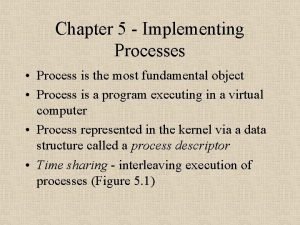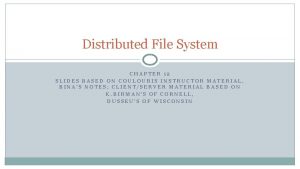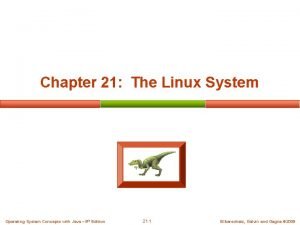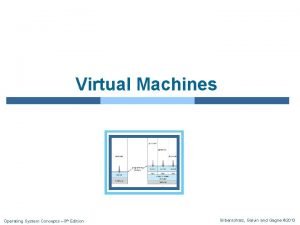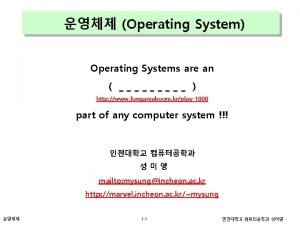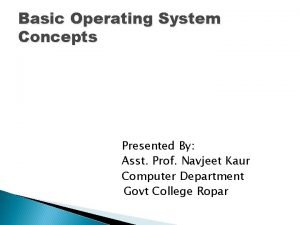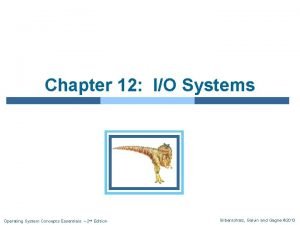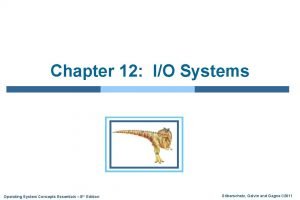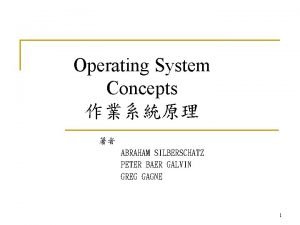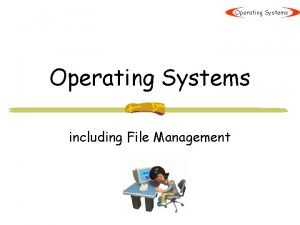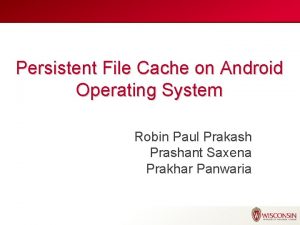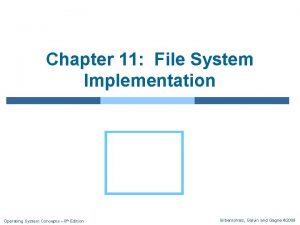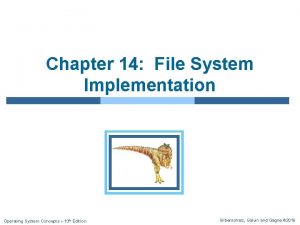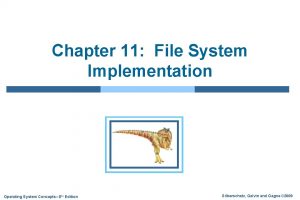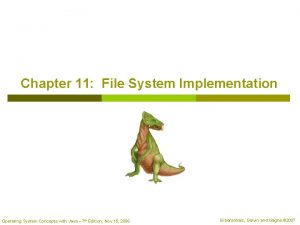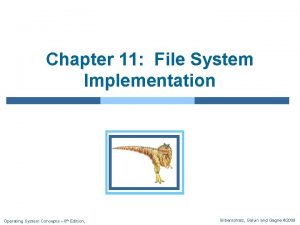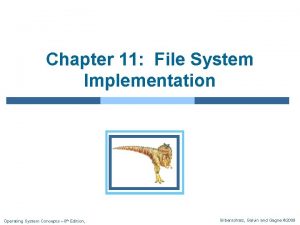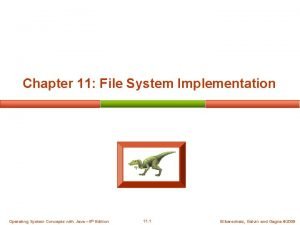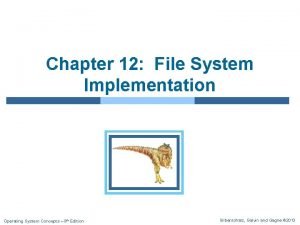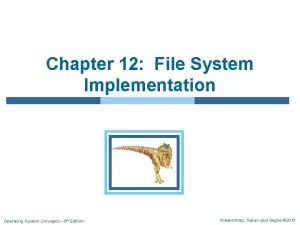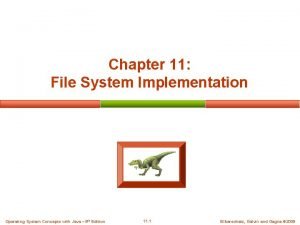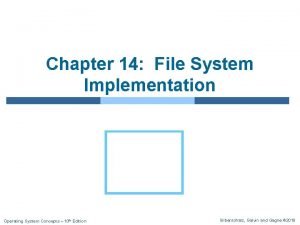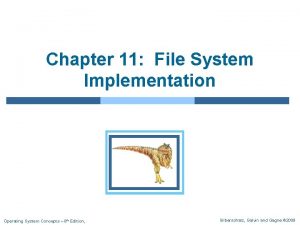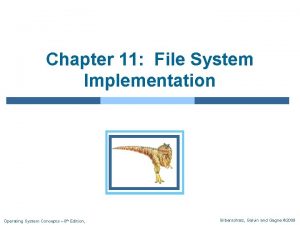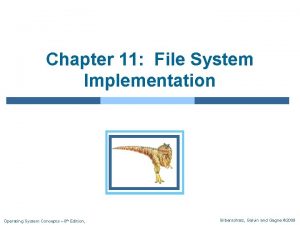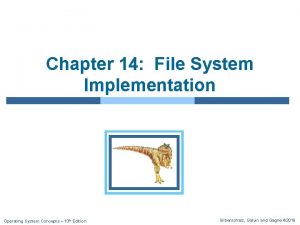File System Implementation Operating System Concepts 8 th





















![Free-Space Management n Bit vector (n blocks) 0 1 2 n-1 … bit[i] = Free-Space Management n Bit vector (n blocks) 0 1 2 n-1 … bit[i] =](https://slidetodoc.com/presentation_image/8a1abccb0f7d5d1e83ec6bcec9feba55/image-22.jpg)








- Slides: 30

File System Implementation Operating System Concepts – 8 th Edition Silberschatz, Galvin and Gagne © 2009

File System Implementation: Objectives n File-System Structure l File-System l Directory Implementation n Allocation Methods l Free-Space Management n Recovery from failure n Remote file access: NFS Operating System Concepts – 8 th Edition 11. 2 Silberschatz, Galvin and Gagne © 2009

Layered File System Operating System Concepts – 8 th Edition 11. 3 Silberschatz, Galvin and Gagne © 2009

File-System Implementation n Boot control block contains info needed by system to boot OS from that volume n Volume control block contains volume details n Directory structure organizes the files n Per-file File Control Block (FCB) contains many details about the file Operating System Concepts – 8 th Edition 11. 4 Silberschatz, Galvin and Gagne © 2009

A Typical File Control Block Operating System Concepts – 8 th Edition 11. 5 Silberschatz, Galvin and Gagne © 2009

In-Memory File System Structures Operating System Concepts – 8 th Edition 11. 6 Silberschatz, Galvin and Gagne © 2009

Virtual File Systems n Virtual File Systems (VFS) provide an object- oriented way of implementing file systems. n VFS allows the same system call interface (the API) to be used for different types of file systems. n The API is to the VFS interface, rather than any specific type of file system. Operating System Concepts – 8 th Edition 11. 7 Silberschatz, Galvin and Gagne © 2009

Schematic View of Virtual File System Operating System Concepts – 8 th Edition 11. 8 Silberschatz, Galvin and Gagne © 2009

Directory Implementation n Linear list of file names with pointer to the data blocks. l simple to program l time-consuming to execute n Hash Table – linear list with hash data structure. l decreases directory search time l collisions – situations where two file names hash to the same location Operating System Concepts – 8 th Edition 11. 9 Silberschatz, Galvin and Gagne © 2009

Allocation Methods n An allocation method refers to how disk blocks are allocated for files: n Contiguous allocation n Linked allocation n Indexed allocation Operating System Concepts – 8 th Edition 11. 10 Silberschatz, Galvin and Gagne © 2009

Contiguous Allocation of Disk Space Operating System Concepts – 8 th Edition 11. 11 Silberschatz, Galvin and Gagne © 2009

Contiguous Allocation n Each file occupies a set of contiguous blocks on the disk n Advantages: l Simple – only starting location (block #) and length (number of blocks) are required l Fast Random access n Disadvantages: l Not easy to grow files. l Wasteful of space (e. g. external fragmentation) Operating System Concepts – 8 th Edition 11. 12 Silberschatz, Galvin and Gagne © 2009

Linked Allocation n Each file is a linked list of disk blocks: blocks may be scattered anywhere on the disk. block = pointer Operating System Concepts – 8 th Edition 11. 13 Silberschatz, Galvin and Gagne © 2009

MS-DOS: File-Allocation Table Operating System Concepts – 8 th Edition 11. 14 Silberschatz, Galvin and Gagne © 2009

Linked Allocation (Cont. ) n Advantages l Simple – need only starting address l Free-space management system – no waste of space n Disadvantages: l No random access n Logical address mapping Q-th block LA/511 R - offset Block to be accessed is the Qth block in the linked chain of blocks representing the file. Displacement into block = R + 1 Operating System Concepts – 8 th Edition 11. 15 Silberschatz, Galvin and Gagne © 2009

Indexed Allocation n Brings all pointers together into the index block n Logical view index table Operating System Concepts – 8 th Edition 11. 16 Silberschatz, Galvin and Gagne © 2009

Example of Indexed Allocation Operating System Concepts – 8 th Edition 11. 17 Silberschatz, Galvin and Gagne © 2009

Indexed Allocation (Cont. ) n Advantages Support dynamic random access l No external fragmentation. l n Disadvantages: l Space overhead to store index blocks n Mapping from logical to physical in a file of maximum size of 256 K words and block size of 512 words. We need only 1 block for index table Q LA/512 R Q = displacement into index table R = offset within a block Operating System Concepts – 8 th Edition 11. 18 Silberschatz, Galvin and Gagne © 2009

Indexed Allocation – Mapping (Cont. ) outer-index table Operating System Concepts – 8 th Edition 11. 19 file Silberschatz, Galvin and Gagne © 2009

Indexed Allocation – Mapping (Cont. ) n Two-level index (maximum file size is 5123 words) Q 1 LA / (512 x 512) R 1 Q 1 = displacement into outer-index R 1 is used as follows: Q 2 R 1 / 512 R 2 Q 2 = displacement into block of index table R 2 displacement into block of file: Operating System Concepts – 8 th Edition 11. 20 Silberschatz, Galvin and Gagne © 2009

Combined Scheme: UNIX UFS (4 K bytes per block) Operating System Concepts – 8 th Edition 11. 21 Silberschatz, Galvin and Gagne © 2009
![FreeSpace Management n Bit vector n blocks 0 1 2 n1 biti Free-Space Management n Bit vector (n blocks) 0 1 2 n-1 … bit[i] =](https://slidetodoc.com/presentation_image/8a1abccb0f7d5d1e83ec6bcec9feba55/image-22.jpg)
Free-Space Management n Bit vector (n blocks) 0 1 2 n-1 … bit[i] = 0 block[i] free 1 block[i] occupied Block number calculation (number of bits per word) * (number of 0 -value words) + offset of first 1 bit Operating System Concepts – 8 th Edition 11. 22 Silberschatz, Galvin and Gagne © 2009

Free-Space Management (Cont. ) n Bit map requires extra space l Example: block size = 212 bytes disk size = 230 bytes (1 gigabyte) n = 230/212 = 218 bits (or 32 K bytes) n Linked list (free list) l Advantages: 4 Do not need contiguous space 4 No waste of space Operating System Concepts – 8 th Edition 11. 23 Silberschatz, Galvin and Gagne © 2009

Performance n disk cache – separate section of main memory for frequently used blocks n free-behind and read-ahead – techniques to optimize sequential access n improve PC performance by dedicating section of memory as virtual disk, or RAM disk Operating System Concepts – 8 th Edition 11. 24 Silberschatz, Galvin and Gagne © 2009

I/O Using a Unified Buffer Cache Operating System Concepts – 8 th Edition 11. 26 Silberschatz, Galvin and Gagne © 2009

Recovery n Consistency checking – compares data in directory structure with data blocks on disk, and tries to fix inconsistencies n Use system programs to back up data from disk to another storage device n Recover lost file or disk by restoring data from backup Operating System Concepts – 8 th Edition 11. 27 Silberschatz, Galvin and Gagne © 2009

Log Structured File Systems n Log structured file systems record each update to the file system as a transaction n All transactions are written to a log l l A transaction is considered committed once it is written to the log However, the file system may not yet be updated n The transactions in the log are asynchronously written to the file system l When the file system is modified, the transaction is removed from the log n If the file system crashes, all remaining transactions in the log must still be performed Operating System Concepts – 8 th Edition 11. 28 Silberschatz, Galvin and Gagne © 2009

The Sun Network File System (NFS) n Transparent shared file access among independent machines and file systems l A remote directory is mounted over a local file system directory 4 The mounted directory looks like an integral subtree of the local file system Operating System Concepts – 8 th Edition 11. 29 Silberschatz, Galvin and Gagne © 2009

Schematic View of NFS Architecture Operating System Concepts – 8 th Edition 11. 30 Silberschatz, Galvin and Gagne © 2009

NFS Protocol n Provides a set of remote procedure calls (RPC) for remote file operations: l searching for a file within a directory l reading a set of directory entries l manipulating links and directories l accessing file attributes l reading and writing files n NFS servers are stateless; each request has to provide a full set of arguments n Modified data must be committed to the server’s disk before results are returned to the client n Support data exchange format conversion using an External Data Representation (XDR) protocol Operating System Concepts – 8 th Edition 11. 31 Silberschatz, Galvin and Gagne © 2009
 File-file yang dibuat oleh user pada jenis file di linux
File-file yang dibuat oleh user pada jenis file di linux File system in operating system
File system in operating system Ufs4.0
Ufs4.0 File system in operating system
File system in operating system Implementation of process in operating system
Implementation of process in operating system Distributed file system implementation
Distributed file system implementation Operating system concepts, 10th edition
Operating system concepts, 10th edition Linux operating system concepts
Linux operating system concepts Operating system concepts with java
Operating system concepts with java Operating system concepts 6th edition
Operating system concepts 6th edition Operating system concepts 9
Operating system concepts 9 Real time operating system concepts
Real time operating system concepts 교보 drm
교보 drm Operating system concepts chapter 8 solutions
Operating system concepts chapter 8 solutions Operating system concepts chapter 5 solutions
Operating system concepts chapter 5 solutions Operating system concepts chapter 5 solutions
Operating system concepts chapter 5 solutions Basic concepts of os
Basic concepts of os Operating system concepts 11th
Operating system concepts 11th Operating system concepts essentials
Operating system concepts essentials Operating system concepts essentials
Operating system concepts essentials Galvin os
Galvin os File management in operating system
File management in operating system File management in android operating system
File management in android operating system Components of an operating system
Components of an operating system Distributed file system definition
Distributed file system definition In a file-oriented information system, a transaction file
In a file-oriented information system, a transaction file Operating systems concepts
Operating systems concepts Geography: realms, regions, and concepts (doc or html) file
Geography: realms, regions, and concepts (doc or html) file Module 4 operating systems and file management
Module 4 operating systems and file management Physical image vs logical image
Physical image vs logical image Fungsi dari create file pada operasi-operasi file (cont.)
Fungsi dari create file pada operasi-operasi file (cont.)




